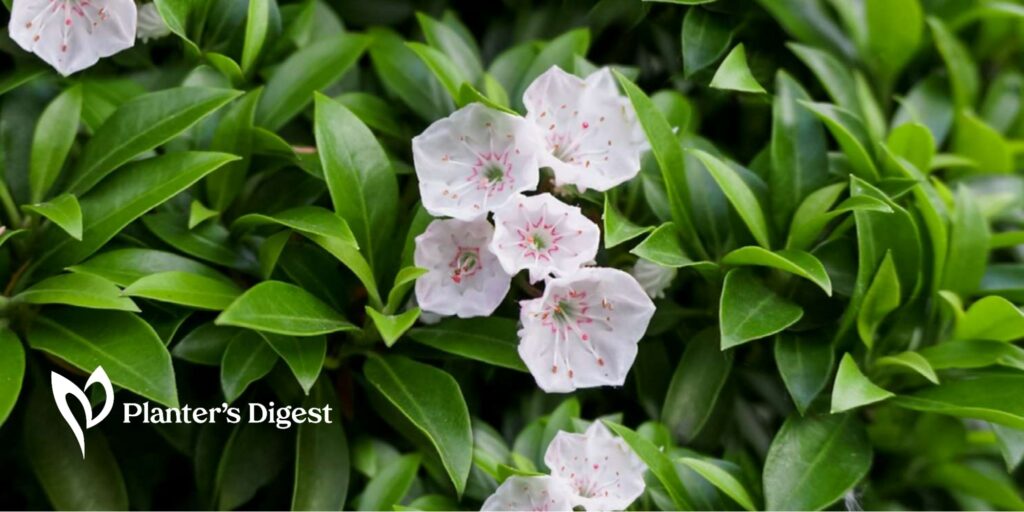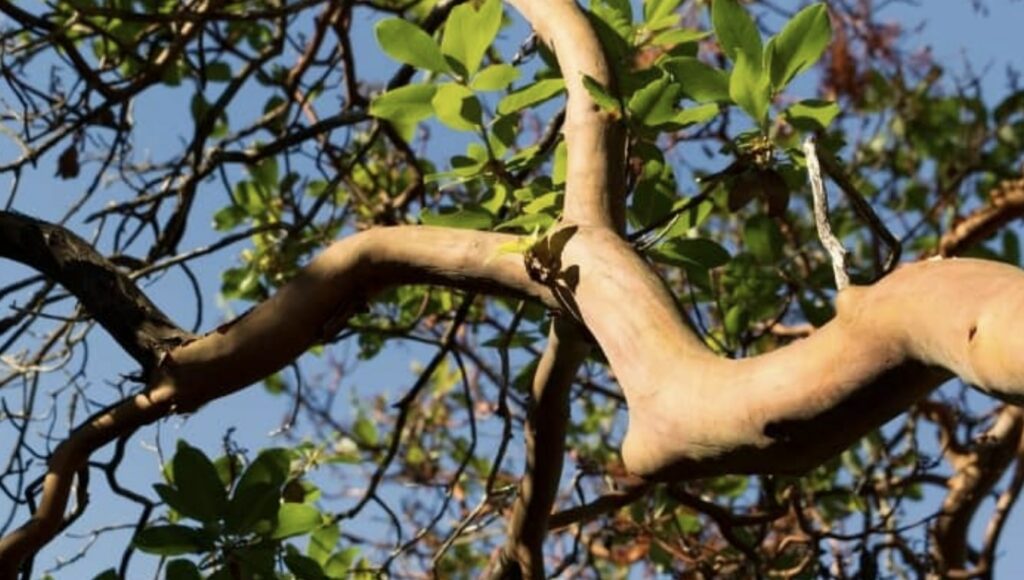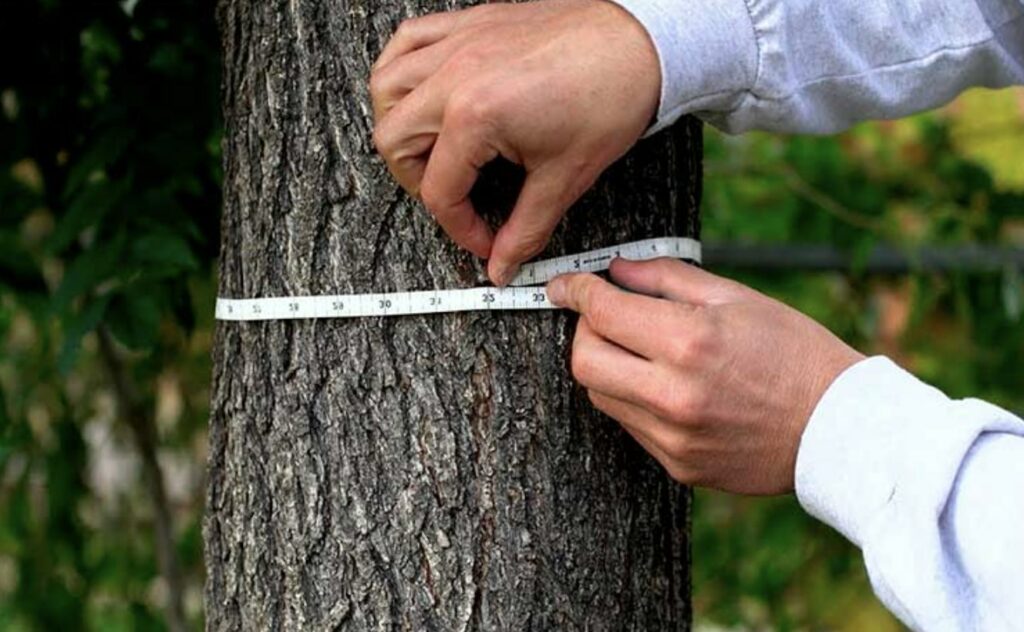Oh, the shade of it all! We’re talking about evergreen trees that grow in the shade and not about putting down the sun-loving ones.
Today, we’ll be tackling gorgeous greenery that brings excitement or calm to your outdoor spaces. These remarkable trees are a gardener’s best friend when it comes to creating a lush landscape in shaded areas – here are 20 of them.
Yew Trees (Taxus spp.)
| Factor | Description |
| Ease of Growth | Moderate ●●○○○ |
| USDA Zone | Varies by species, typically Zones 4 to 7 |
| Height/Width | Height: 2 to 80 feet (depending on species), Width: 2 to 20 feet |
| Growth Rate | Slow to moderate growth rate |
| Propagation | By seed, cuttings, or layering |
| Possible Issues | Susceptible to several pests and diseases, such as scale insects and Phytophthora root rot. Berries are toxic if consumed. |
Yew trees thrive in different light conditions, from partial to full shade with dense, dark green foliage and produce red berries. They aren’t too picky and can grow in various soil types although they grow best in moderately fertile, loamy soil with good drainage.
Yew trees have moderate water needs as they prefer consistently moist but not waterlogged soil, especially during dry spells. Common uses include ornamental shrubs, hedges, and topiary due to their evergreen foliage, which is quite attractive.
Japanese Plum Yew (Cephalotaxus harringtonia)
| Factor | Description |
| Ease of Growth | Moderate ●●○○○ |
| USDA Zone | Typically Zones 6 to 9 |
| Height/Width | Height: 5 to 10 feet, Width: 3 to 6 feet |
| Growth Rate | Slow to moderate growth rate |
| Propagation | By seed or cuttings |
| Possible Issues | Generally pest and disease-resistant |
The Japanese Plum Yew, with its needle-like foliage, loves to grow in different shade conditions, from partial to full shade. It can grow in various soil types, though it prefers well-drained, loamy soil. It adapts well to different soils.
Japanese Plum Yew is often used in landscaping for ornamental purposes and suits shaded or woodland gardens. Its compact, upright growth makes it ideal for hedges, borders, or foundation planting.
Holly Trees (Ilex spp.)
| Factor | Description |
| Ease of Growth | Moderate ●●○○○ |
| USDA Zone | Typically Zones 5 to 9 |
| Height/Width | Height: 6 to 50 feet (depending on species), Width: 6 to 20 feet |
| Growth Rate | Moderate growth rate |
| Propagation | By seeds or cuttings |
| Possible Issues | Susceptible to some pests and diseases, such as scale insects and leaf spot |
Holly trees are known for their shiny, dark green leaves and the bright red berries they bear. They adapt to various light conditions, from full sun to partial shade.
Well-drained soil works well, and they are adaptable to loamy or sandy soil, as long as it remains consistently moist. These trees serve as accent plants in landscaping due to their evergreen leaves and bright red berries for holiday decorations and wreaths.
Eastern Red Cedar (Juniperus virginiana)
| Factor | Description |
| Ease of Growth | Moderate ●●○○○ |
| USDA Zone | Varies by species, typically Zones 3 to 8 |
| Height/Width | Height and width vary depending on the specific species and environmental conditions |
| Growth Rate | Typically moderate growth rate |
| Propagation | Typically propagated by seeds or cuttings |
| Possible Issues | Generally resilient but may be susceptible to diseases and pests, such as deer browsing and fungal diseases |
These evergreen plants benefit wildlife lovers by offering food and shelter to various species. They adapt well to different light conditions, including partial shade, making them perfect for multiple types of landscaping styles.
Generally, they like well-drained, moderately fertile soil but specific species may have different requirements. They usually have moderate watering needs so strike a balanced soil moisture to keep them beautiful protective habitats for you and the wildlife.
Mountain Laurel (Kalmia latifolia)
| Factor | Description |
| Ease of Growth | Moderate ●●○○○ |
| USDA Zone | Typically Zones 5 to 9 |
| Height/Width | Height: 3 to 18 feet, Width: 3 to 12 feet |
| Growth Rate | Moderate growth rate |
| Propagation | Typically propagated from seeds |
| Possible Issues | Susceptible to fungal diseases, such as leaf spot and root rot. All parts of the plant, including leaves, stems, and flowers, contain toxic compounds and should not be ingested. |
Mountain laurels stand out for their showy, highly attractive bell-shaped flowers, growing well in shaded spots. Mountain laurels flourish in dappled to partial shade, ideal for gardens with limited direct sunlight.
They prefer well-drained, acidic soils that are kept consistently moist but not waterlogged as they have moderate watering needs. Mountain laurels are grown for their ornamental value and are commonly used in woodland or native plant gardens.
Boxwood (Buxus spp.)
| Factor | Description |
| Ease of Growth | Moderate ●●○○○ |
| USDA Zone | Zones 4 to 9 |
| Height/Width | Height: 1 to 20 feet, Width: 1 to 15 feet |
| Growth Rate | Slow to moderate growth rate |
| Propagation | Typically through cuttings or transplanting young plants |
| Possible Issues | Susceptible to certain pests and diseases, including boxwood blight and leafminer damage |
Boxwood is known for its dense, compact growth and dark green foliage – a classic pick for formal gardens and hedges. It thrives in partial to full sun, although it can manage partial shade but it might not get as dense as those grown in full sun.
It’s not overly fussy about soil pH and adapts to various soil types as long as they’re well-draining and fertile. Keeping the soil consistently moist, especially during the establishment phase, is crucial for their well-being.
Azaleas (Rhododendron spp.)
| Factor | Description |
| Ease of Growth | Moderate ●●○○○ |
| USDA Zone | Varies by species, typically Zones 4 to 9 |
| Height/Width | Height: 1 to 8 feet, Width: 2 to 10 feet |
| Growth Rate | Moderate growth rate |
| Propagation | Typically propagated by cuttings or layering |
| Possible Issues | Susceptible to certain pests and diseases, such as lace bugs and powdery mildew |
Azaleas, also known as Rhododendron spp., are famous for their vibrant spring flowers that burst with color in partial to full shade. They prefer acidic, well-drained soil and you can improve their overall health by adding organic matter to maintain the right pH level.
Azaleas need regular moisture, especially in dry spells, but avoid making the soil waterlogged. They fit perfectly in borders, hedges, and woodland gardens, bringing a pop of color to any area in brilliant shades of pink, red, purple, and white.
American Holly (Ilex opaca)
| Factor | Description |
| Ease of Growth | Moderate ●●○○○ |
| USDA Zone | Varies by species, typically Zones 5 to 9 |
| Height/Width | Height: 15 to 30 feet, Width: 10 to 20 feet (but can be pruned to desired size) |
| Growth Rate | Slow to moderate growth rate |
| Propagation | Typically propagated by seed or cuttings |
| Possible Issues | Susceptible to certain pests and diseases, including holly leaf miner and scale insects. Bright red berries are toxic if consumed. |
American Holly is known for its spiky leaves and vibrant red berries commonly used in holiday decorations. This plant can adapt to various light conditions but thrives in partial to full sun.
American Holly prefers well-drained, slightly acidic soil with some moisture retention as it has moderate watering needs. The spiky leaves not only provide visual appeal but also deter unwanted garden visitors.
Japanese Andromeda (Pieris japonica)
| Factor | Description |
| Ease of Growth | Moderate ●●○○○ |
| USDA Zone | Typically Zones 5 to 8 |
| Height/Width | Height: 6 to 12 feet, Width: 6 to 8 feet |
| Growth Rate | Moderate growth rate |
| Propagation | By cuttings or layering |
| Possible Issues | Susceptible to lace bugs and root rot if soil drainage is poor |
Japanese Andromeda is grown for its lovely hanging clusters of white or pink flowers, even though it thrives in partial shade and some morning sun. It thrives in acidic soil, so ensure the pH is right for its growth so just add organic matter to maintain the acidity.
For watering, aim for moderate and consistent moisture without overwatering, as it can cause waterlogged conditions.
Inkberry (Ilex glabra)
| Factor | Description |
| Ease of Growth | Moderate ●●○○○ |
| USDA Zone | Typically Zones 4 to 9, can vary by species |
| Height/Width | Height: 3 to 8 feet, Width: 4 to 6 feet |
| Growth Rate | Moderate growth rate |
| Propagation | Typically propagated by seeds or cuttings |
| Possible Issues | Generally low susceptibility to pests and diseases; however, watch for leaf spot and scale insects |
The Inkberry is a native evergreen shrub with dark green leaves and small, black berries that thrives in shaded, wet areas. It prefers shade but can handle partial sun, making it a good choice for areas with limited sunlight.
Plant it in well-drained, moist ground with consistent moisture like rain gardens or near water features. It’s suitable for formal hedges and naturalistic garden designs with its black berries attracting wildlife, like birds, to your garden.
Sarcococca (Sarcococca spp.)
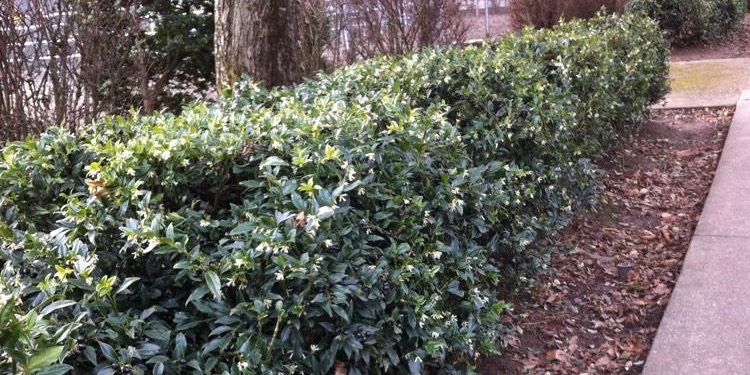
| Factor | Description |
| Ease of Growth | Moderate ●●○○○ |
| USDA Zone | Typically Zones 7-9 |
| Height/Width | Height: 1-6 feet, Width: 3-4 feet |
| Growth Rate | Slow, compact growth |
| Propagation | By cuttings or division |
| Possible Issues | Generally pest and disease-resistant |
Sarcococca, or sweet box, is blessed with small, fragrant white flowers that come out most of the year, particularly in winter. Sweet box thrives in shaded spots and can even handle deep shade, perfect for low-light areas and dim corners.
These plants prefer well-drained, moderately fertile soil of various types. Gardeners often use sweet boxes to add winter fragrance, even when grown in small shady spaces in need of beauty and fragrance.
False Cypress (Chamaecyparis spp.)
| Factor | Description |
| Ease of Growth | Moderate ●●○○○ |
| USDA Zone | Varies by species, typically Zones 4 to 8 |
| Height/Width | Height and width vary by species and cultivar, generally compact to medium-sized |
| Growth Rate | Moderate growth rate |
| Propagation | Primarily by cuttings, seeds for some species |
| Possible Issues | Some species susceptible to spider mites and aphids |
False Cypress trees thrive in different lighting conditions, going from partial shade to full sun. These trees typically prefer slightly acidic, well-drained soil as they’re not too picky about soil type but do best in well-draining conditions.
False Cypress trees are commonly used for ornamental landscaping because of their diverse shapes and sizes. They can serve as standalone specimens, hedges, or grouped together to enhance garden aesthetics.
Japanese Umbrella Pine (Sciadopitys verticillata)
| Factor | Description |
| Ease of Growth | Moderate ●●○○○ |
| USDA Zone | Typically Zones 5 to 7, but may vary with local climate |
| Height/Width | Height: Up to 60 feet, Width: Up to 20 feet |
| Growth Rate | Slow to moderate growth rate |
| Propagation | Usually by seeds or cuttings |
| Possible Issues | Generally hardy, but susceptible to root rot in waterlogged soil |
The Japanese Umbrella Pine is recognized for its distinctive whorls of dark green needles. It can thrive in conditions where many other evergreens might struggle as long as it’s grown in well-draining, loamy, slightly acidic soils.
This tree is often planted for its ornamental beauty, making it a great addition to both residential and public landscapes. Its ability to thrive in shade distinguishes it from many other evergreen trees, making it a valuable addition to gardens with limited sunlight.
Andean Cocoon Tree (Oreocereus celsianus)
| Factor | Description |
| Ease of Growth | Moderate ●●○○○ |
| USDA Zone | Typically suited for Zones 9 to 11 |
| Height/Width | Height: 10 to 30 feet, Width: 8 to 15 feet |
| Growth Rate | Slow to moderate growth rate |
| Propagation | By seeds or stem cuttings |
| Possible Issues | Vulnerable to root rot if overwatered; otherwise, relatively pest and disease resistant |
The Andean Cocoon Tree does well in filtered sunlight or partial shade as it doesn’t need intense sunlight. Well-draining soil is best for this succulent-like tree, preferably a cactus or succulent mix to prevent overwatering.
Andean Cocoon Trees are often grown as ornamental plants in gardens or as potted indoor plants due to their distinctive appearance. What makes them stand out is their cactus-like look, making them an eye-catching addition to gardens or indoor spaces.
Daphne (Daphne spp.)
| Factor | Description |
| Ease of Growth | Moderate ●●○○○ |
| USDA Zone | Typically Zones 4 to 9 |
| Height/Width | Height: 2 to 6 feet, Width: 2 to 4 feet |
| Growth Rate | Slow to moderate growth rate |
| Propagation | Usually propagated through cuttings or layering |
| Possible Issues | Prone to pests and diseases, including aphids, mealybugs, and leaf spot; sensitive to overwatering and poor drainage |
Daphne shrubs do best in dappled shade or partial sun and can handle some morning sun but should avoid the harsh afternoon sun. They prefer well-draining soil with good organic matter and should be kept moist without overwatering to prevent root rot.
Their sweet-scented flowers bloom in late winter or early spring when other plants are dormant, adding early-season fragrance. However, Daphne shrubs can be a bit finicky, requiring specific care and conditions to thrive.
Siberian Cypress (Microbiota decussata)
| Factor | Description |
| Ease of Growth | Moderate ●●○○○ |
| USDA Zone | Typically Zones 2 to 7 |
| Height/Width | Height: 6 to 12 inches, Width: 2 to 4 feet |
| Growth Rate | Slow to moderate growth rate |
| Propagation | Propagated by seeds or cuttings |
| Possible Issues | Generally disease-resistant, but watch for root rot in overly wet conditions |
Siberian Cypress is valued for its low, spreading growth, perfect for shaded rock gardens, creating a lush green carpet. This ground cover prefers well-drained soil and can endure rocky or poor soil, making it the ideal plant for less fertile rock gardens.
Once established, Siberian Cypress can handle drought, but during the initial growth phase, it needs consistent soil moisture. Avoid excessive watering to prevent root rot.
Sweetspire (Itea spp.)
| Factor | Description |
| Ease of Growth | Moderate ●●○○○ |
| USDA Zone | Typically Zones 5 to 9 |
| Height/Width | Height: 3 to 5 feet, Width: 3 to 6 feet |
| Growth Rate | Moderate growth rate |
| Propagation | Typically propagated by cuttings or division |
| Possible Issues | Susceptible to root rot in poorly drained soils |
Sweetspire shrubs are famous for their sweet-smelling white flowers and striking autumn leaves. These shrubs can endure various light conditions, but they flourish in partial shade and consistently moist, well-drained, and slightly acidic soil.
Sweetspire shrubs are a favorite for their fragrant white flowers and their captivating fall foliage. Plant them near spaces where you like to hang out or near windows to let their fragrance waft inside your home.
Chinese Fringe Flower (Loropetalum chinense)
| Factor | Description |
| Ease of Growth | Moderate ●●○○○ |
| USDA Zone | Zones 6 to 9 for most varieties |
| Height/Width | Height: 3 to 10 feet, Width: 3 to 10 feet |
| Growth Rate | Moderate growth rate |
| Propagation | Typically propagated by cuttings or seeds |
| Possible Issues | Prone to pests such as aphids and spider mites; watch for powdery mildew in humid conditions |
Chinese Fringe Flower has eye-catching pink or white fringe-like flowers, making it a lovely garden addition since it’s adaptable to various growing conditions and can thrive in partial shade. It can handle full sun, but you need to keep a close eye on watering.
This plant prefers well-draining, slightly acidic soil but avoid overwatering the soil as it can result in root rot. It serves well as a hedge, foundation plant, or even as a garden specimen to show off the fringe-like flowers to contrast with the garden greenery.
Oregon Grape Holly (Mahonia aquifolium)
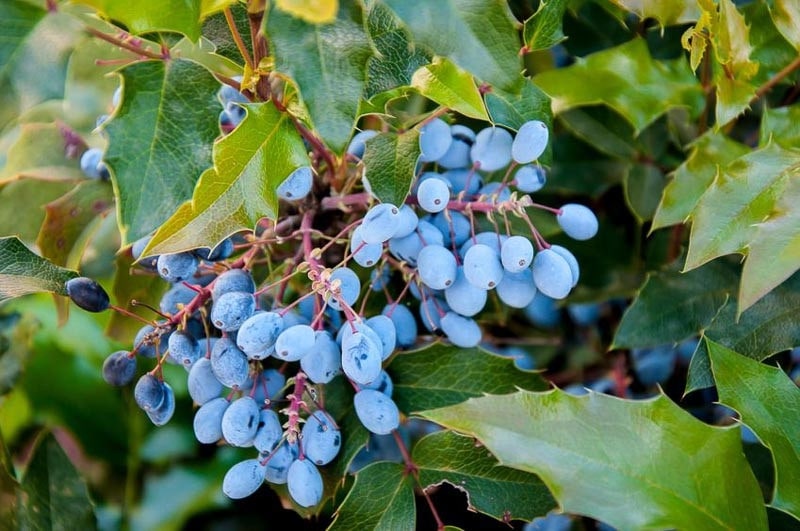
| Factor | Description |
| Ease of Growth | Moderate ●●○○○ |
| USDA Zone | Typically Zones 5 to 9, varying slightly depending on the species |
| Height/Width | Height: 2 to 6 feet, Width: 3 to 5 feet |
| Growth Rate | Slow to moderate growth rate |
| Propagation | Can be propagated by division or from seeds |
| Possible Issues | Generally hardy, but may be susceptible to rust and black spot diseases in certain conditions |
Oregon Grape Holly has holly-like leaves and clusters of bright yellow flowers and thrives in shade and adapts to various light conditions, from full shade to partial sun.
It can grow in different well-drained soil types, but it’s happiest in loamy or sandy soils.
Common uses include ornamental shrubs or hedges due to its holly-like appearance and attractive yellow flowers. It also attracts pollinators like bees to your garden.
Wintercreeper (Euonymus fortunei)
| Factor | Description |
| Ease of Growth | Moderate ●●○○○ |
| USDA Zone | Varies by species, typically Zones 4 to 9 |
| Height/Width | Height: 1 to 2 feet, Width: 5 to 8 feet |
| Growth Rate | Fast-growing |
| Propagation | Easily propagated by cuttings or division |
| Possible Issues | Potential for invasive growth, can become problematic in some regions, may require regular pruning |
Wintercreeper is a great low-maintenance ground cover plant known for its variegated foliage for shaded spots in your garden. The Wintercreeper thrives in shade but can tolerate partial sun and adapts to various soils but prefers well-draining ones.
It’s perfect for adding texture and color to shady areas and erosion control on slopes. Its variegated foliage is a standout, adding color and vibrancy to low-light areas, but note that in some regions, it can be invasive and may need regular pruning.


